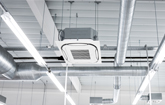BorgWarner Developed Key Technology for Hybrid and Electric Vehicles
- Provides heating function for hybrid and electric vehicles with limited waste heat
- Facilitates superior energy management for enhanced battery-powered driving range
- Patented heater rod and advanced fin designs deliver safe heater operation and industry-first dual-zone functionality
AUBURN HILLS, Mich., May 2, 2017 /PRNewswire/ -- Tackling the challenges posed by an increase in hybrid (HEVs) and electric vehicles (EVs), BorgWarner developed a leading high-voltage positive temperature coefficient (PTC) cabin heater as a waste heat independent heating solution. The advanced, lightweight solution provides rapid and silent warming of the cabin as well as quick defrosting of the windshield while delivering a smooth air stream for maximum comfort. Moreover, the component's design includes several prominent safety features to ensure reliable operation under temperature conditions found in the vehicle.
"Heating up the cabin can be challenging if the waste heat available is limited. This is where our high-voltage cabin heater comes in. Specifically engineered to help automakers worldwide reach their objectives, our efficient heating technology provides them with an ideal solution for a safe, comfortable and odor-free cabin environment," said Joe Fadool, President and General Manager, BorgWarner Emissions & Thermal Systems. "At BorgWarner, we are constantly working on developing innovative solutions for all kinds of propulsion systems to help preserve the environment by increasing the efficiency of modern vehicles."
As part of the heating, ventilation and air conditioning (HVAC) system and controlled through a high-speed Controller Area Network (CAN) interface, BorgWarner's high-voltage PTC cabin heater is engineered to increase the temperature of the air stream coming from the blower. It features ceramic PTC components that have very low electrical resistance at low temperatures, allowing full current flow and high heat delivery. At high temperatures, the effect is reversed and less heat is released by shutting down the electricity flow due to the increased resistance of the ceramic stones. This provides desirable control while also functioning as a basic safety feature that prevents overheating. Additional safety features include an enclosed heater rod for maximum protection against high voltages. Coupled with the enclosed heater rod, the air heater's fin design facilitates a low pressure drop, enabling the blower to run at lower speeds, which reduces air velocity and noise for the occupants. Combined, the heater rod and fin designs provide the industry's first dual-zone functionality in a PTC heater, allowing the precise and smooth delivery of individual temperatures for driver and passenger and eliminating the waste caused by single-zone heaters.
BorgWarner's PTC cabin heater is part of the company's broad range of products for electrically driven vehicles. Covering four of the five main technology segments for electric propulsion – electric motors, transmissions, power electronics and thermal management – BorgWarner already supports several leading automakers with products such as the electric drive module (eDM) and its high voltage hairpin (HVH) electric motors.
About BorgWarner
BorgWarner Inc. (NYSE: BWA) is a global product leader in clean and efficient technology solutions for combustion, hybrid and electric vehicles. With manufacturing and technical facilities in 62 locations in 17 countries, the company employs approximately 27,000 worldwide. For more information, please visit borgwarner.com.
BorgWarner's high-voltage positive temperature coefficient (PTC) cabin heater offers a comfortable cabin environment for both driver and passengers while contributing to increased safety and battery-powered driving range for hybrid and electric vehicles.
Statements contained in this news release may contain forward-looking statements as contemplated by the 1995 Private Securities Litigation Reform Act that are based on management's current outlook, expectations, estimates and projections. Words such as "anticipates," "believes," "continues," "could," "designed," "effect," "estimates," "evaluates," "expects," "forecasts," "goal," "initiative," "intends," "outlook," "plans," "potential," "project," "pursue," "seek," "should," "target," "when," "would," variations of such words and similar expressions are intended to identify such forward-looking statements. Forward-looking statements are subject to risks and uncertainties, many of which are difficult to predict and generally beyond our control, that could cause actual results to differ materially from those expressed, projected or implied in or by the forward-looking statements. Such risks and uncertainties include: fluctuations in domestic or foreign vehicle production, the continued use by original equipment manufacturers of outside suppliers, fluctuations in demand for vehicles containing our products, changes in general economic conditions, as well as other risks noted reports that we file with the Securities and Exchange Commission, including the Risk Factors identified in our most recently filed Annual Report on Form 10-K. We do not undertake any obligation to update or announce publicly any updates to or revision to any of the forward-looking statements.
SOURCE BorgWarner
Related Links
WANT YOUR COMPANY'S NEWS FEATURED ON PRNEWSWIRE.COM?
Newsrooms &
Influencers
Digital Media
Outlets
Journalists
Opted In






Share this article